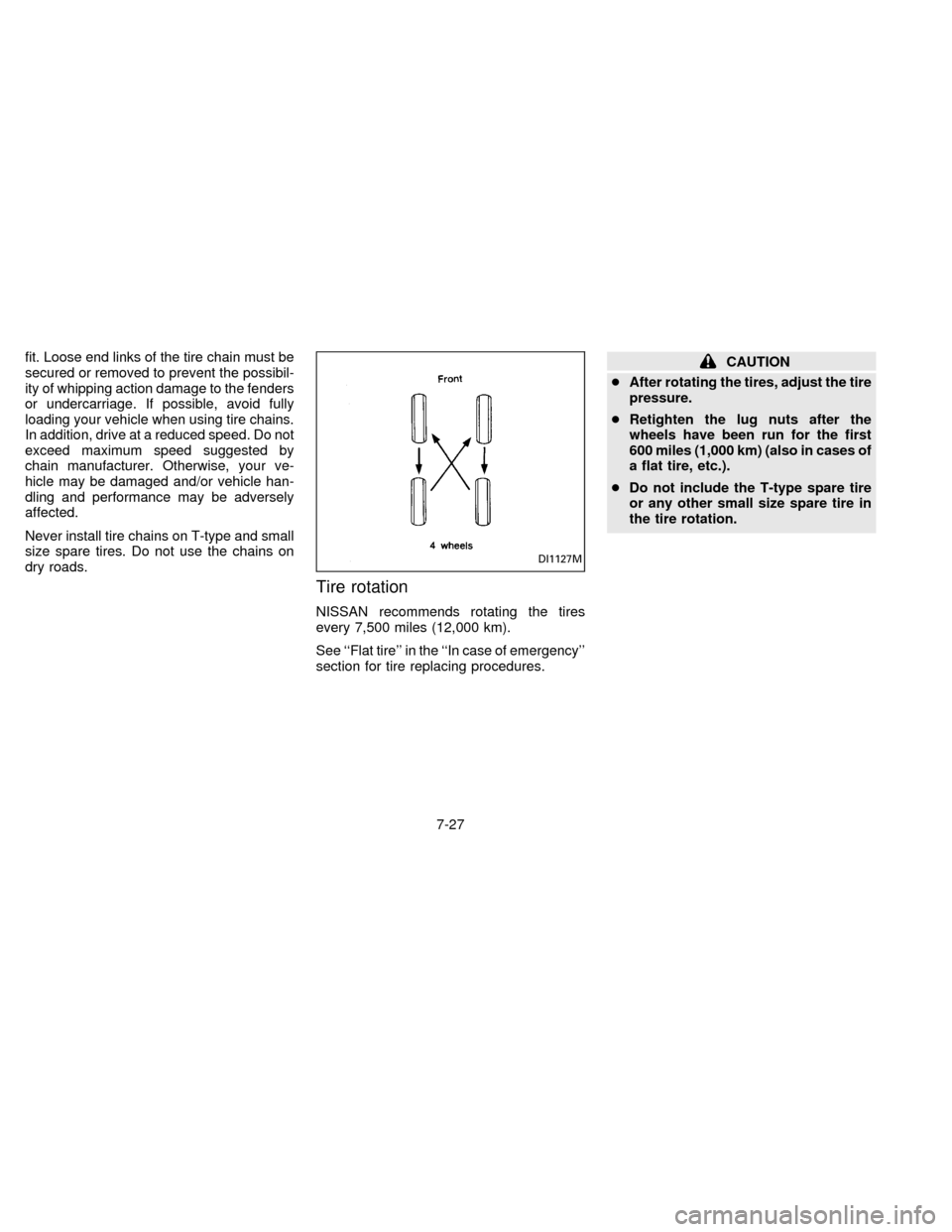Page 142 of 235

During the first 1,000 miles (1,600 km),
follow these recommendations for the future
reliability and fuel economy of your new
vehicle. Failure to follow these recommen-
dations may result in vehicle damage or
shortened engine life.
cDo not drive over 55 MPH (90 km/h) and
do not run the engine over 4,000 rpm.
Avoid driving for long periods at constant
speed, either fast or slow.
cDo not accelerate at full throttle in any
gear.
cAvoid quick starts.
cAvoid hard braking as much as possible.
cDo not tow a trailer for the first 500 miles
(800 km).cAccelerate slowly and smoothly. Main-
tain cruising speeds with a constant ac-
celerator position.
cDrive at moderate speeds on the high-
way. Driving at high speed lowers fuel
economy.
cAvoid unnecessary stopping and brak-
ing. Maintain a safe distance behind
other vehicles.
cUse a proper gear range which suits road
conditions. On level roads, shift into high
gear as soon as possible.
cAvoid unnecessary engine idling.cKeep your engine tuned up.
cFollow the recommended periodic main-
tenance schedule.
cKeep the tires inflated at the correct
pressure. Low pressure increases tire
wear and waste fuel.
cKeep the front wheels in correct align-
ment. Improper alignment causes not
only tire wear but also lower fuel
economy.
cAir conditioner operation lowers fuel
economy. Use the air conditioner only
when necessary.
cWhen cruising at highway speeds, it is
more economical to use the air condi-
tioner and leave the windows closed to
reduce drag.
SD1001M
BREAK-IN SCHEDULE INCREASING FUEL
ECONOMY
4-11
ZX
Page 194 of 235

fit. Loose end links of the tire chain must be
secured or removed to prevent the possibil-
ity of whipping action damage to the fenders
or undercarriage. If possible, avoid fully
loading your vehicle when using tire chains.
In addition, drive at a reduced speed. Do not
exceed maximum speed suggested by
chain manufacturer. Otherwise, your ve-
hicle may be damaged and/or vehicle han-
dling and performance may be adversely
affected.
Never install tire chains on T-type and small
size spare tires. Do not use the chains on
dry roads.
Tire rotation
NISSAN recommends rotating the tires
every 7,500 miles (12,000 km).
See ``Flat tire'' in the ``In case of emergency''
section for tire replacing procedures.
CAUTION
cAfter rotating the tires, adjust the tire
pressure.
cRetighten the lug nuts after the
wheels have been run for the first
600 miles (1,000 km) (also in cases of
a flat tire, etc.).
cDo not include the T-type spare tire
or any other small size spare tire in
the tire rotation.
DI1127M
7-27
ZB13-DX
Page 231 of 235

D
Daytime running light system (Canada
only) ........................................................... 1-13
Defogger switch
Rear window defogger switch .............. 1-12
Dimensions and weights.............................. 9-8
Door locks .................................................... 2-2
Drive belts .................................................. 7-12
Driving
Cold weather driving cautions .............. 4-15
Driving with an automatic transmission .. 4-5
Precautions when driving ..................... 4-13
Precautions when starting and driving ... 4-2
E
Economy - fuel........................................... 4-11
Emission control information label............. 9-10
Emission control system warranty ............. 9-19
Engine .......................................................... 9-7
Before starting the engine ...................... 4-5
Capacities and recommended fuel/
lubricants ................................................ 9-2
Changing engine coolant........................ 7-5
Changing engine oil................................ 7-6
Changing engine oil filter........................ 7-7
Checking engine coolant level ............... 7-4
Checking engine oil level ....................... 7-5
Engine compartment check locations .... 7-3
Engine coolant temperature gauge ........ 1-4
Engine cooling system ........................... 7-4Engine oil ................................................ 7-5Engine oil and oil filter recommendation... 9-4
Engine oil viscosity ................................. 9-5
Engine serial number ............................. 9-9
Starting the engine ................................. 4-8
Exhaust gas (Carbon monoxide) ................. 4-2
F
Five passenger seating ............................. 2-18
Five passenger seating with cargo room .. 2-18
Flashers (See hazard warning flasher switch)
Flat tire ......................................................... 5-2
Flexible seating .......................................... 2-33
Floor mat positioning ................................. 2-17
Floor mat positioning pins ......................... 2-20
Fluid (checking)
Automatic transmission fluid ................... 7-8
Brake fluid............................................. 7-10
Capacities and recommended fuel/
lubricants ................................................ 9-2
Engine coolant ........................................ 7-4
Engine oil ................................................ 7-5
Power steering fluid ................................ 7-9
Window washer fluid ............................ 7-10
F.M.V.S.S. certification label ..................... 9-10
Fuel
Capacities and recommended fuel/
lubricants ................................................ 9-2
Fuel economy ....................................... 4-11
Fuel filler lid and cap ............................ 2-15
Fuel gauge.............................................. 1-5Fuel recommendation ............................. 9-2
Fuses ......................................................... 7-17
Fusible links ............................................... 7-18
G
Gas station information............................ 10-10
Gauge
Engine coolant temperature gauge ........ 1-4
Fuel gauge.............................................. 1-5
Odometer ................................................ 1-4
Speedometer .......................................... 1-4
Tachometer............................................. 1-4
Trip odometer ......................................... 1-4
Gear selection (See shifting)
General maintenance .................................. 8-2
H
Hazard warning flasher switch .................. 1-16
Head restraints .......................................... 2-29
Headlight control switch............................. 1-12
Headlights .................................................. 7-19
Heater
Heater and air conditioner controls ..... 3-11
Rear seat heater and air conditioner ... 3-14
Hood release ............................................. 2-10
I
If your vehicle overheats ............................. 5-9
10-2
ZX